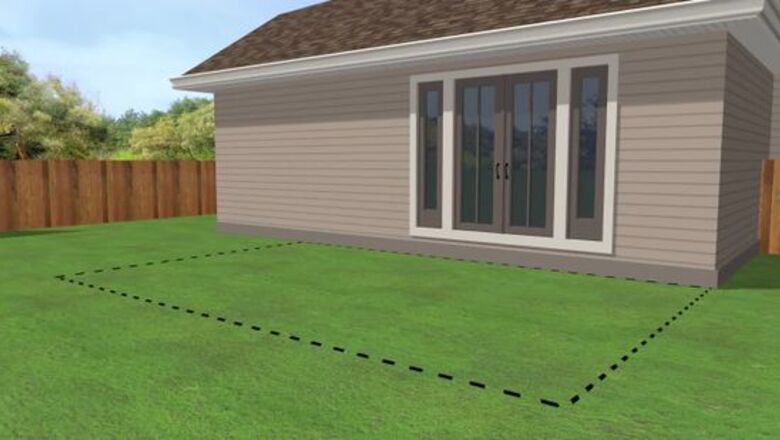
views
Planning for Your Patio
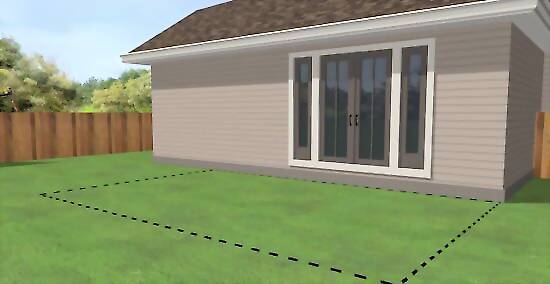
Determine the size and location for your patio. If you've decided to make a patio, you probably already have a location in mind. However, before you get started you should determine the requirements necessary to create the patio. Make sure water drains away from the area. Is the location you initially considered large enough to fit the patio you want? Will certain obstacles force you to use a different layout than you had initially intended? A little time thinking about these issues will make the later steps that much easier. Take into consideration any electrical lines, gas lines for a barbeque, and water pipes that you might already have or are considering installing in the future.
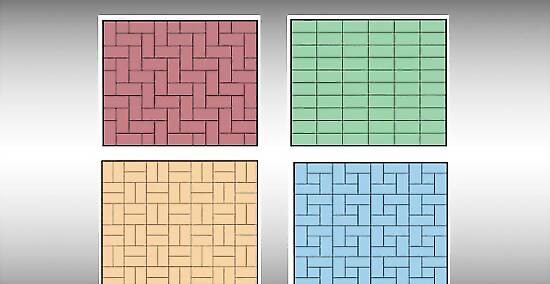
Consider the design that you would like. After you have determined the size, you must consider a few things like the pattern used to place the pavers (the bricks) and the material that will be used as a border. Here are a few points to consider. There are a number of designs you can follow for the pavers. Some of the best known are the "basket weave," the "jack on jack," and the "herringbone." The basket weave or "pinwheel" design involves sets of eight total bricks laid in groups of two, with each pair set together left to right adjoining another pair set at an angle perpendicular to them. The "jack on jack" pattern is a uniform set columns and rows, with each paver set end-to-end and side by side. The herringbone design is a pattern involving pavers abutting to create a ninety-degree angle, with the end of one paver used to cover the end of another. The pattern you select will have a very real impact on the amount of time and energy needed to complete this project. For example, certain paver pattern designs will require you to precisely cut half of the pavers as you reach the edges of your patio, or you will have to purchase specially sized pavers with this in mind. You must also determine if you want a border made of pavers or of wood. Lumber can provide a nice contrast to the pavers, and it is comparatively quick and easy to install. Pavers will take quite a lot more time to install but will seamlessly match the rest of your patio. Pavers made of light aluminum, plastic, or light gauge steel can be anchored down with 10-inch spikes. This kind of edging is great for curves and angles.
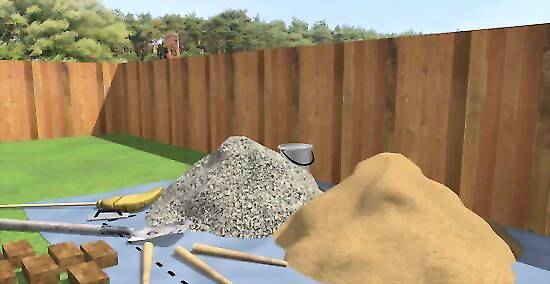
Calculate the amount of supplies you will need. Use your estimate of the size and your thoughts regarding the design of the patio to determine the quantity of the pavers you will need. Of course, there are some additional supplies that will be necessary in order for you to finish this project. A full list of supplies will be provided at the end of this guide, but some in particular are listed here as well. Crushed stone or gravel (typically a ¾ minus road base material) may be used to fill the deepest portions of the excavation floor after you have dug out the area for the patio, providing stability and aiding drainage. You can determine the quantity yourself, but you should use at least 4 inches (10 cm) of crushed stone as the base layer. Calculate the necessary volume of crushed stone or gravel before you head to the home or garden shop. Bedding sand will make up the layer just below the bricks and can be used to fill the gaps between them. Polymeric joint sand can be swept into brick joints to help lock them into place. If you don't use crushed stone or gravel, this will also be the foundation of your patio. Some suggest that a layer just one inch deep is adequate, but others suggest at least twice that amount. You will need to know the volume of sand necessary when you make your purchase. You may want to lay landscape fabric underneath to discourage the growth of weeds. It would require a lot of effort to remove weeds growing through your patio, so it is probably best to stop it before it starts. If you will use lumber along the edges of your patio as support, determine the quality and quantity of pressure-treated lumber you will require. There are a number of varieties available, but for a job like this you will want one rated for ground contact.
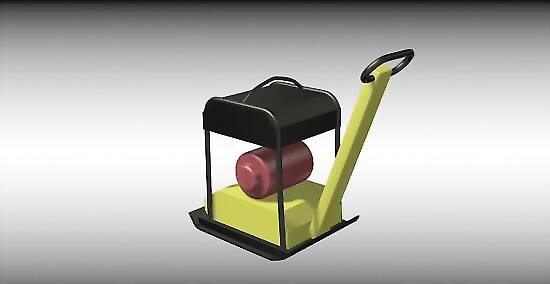
Purchase the necessary materials. You may also want to rent certain equipment, such as a gas-powered tamper to compact the soil and sand (manual tampers are also available for purchase, if you prefer). If you need to do a lot of cutting, look for a diamond-bladed wet masonry saw.
Making the Patio
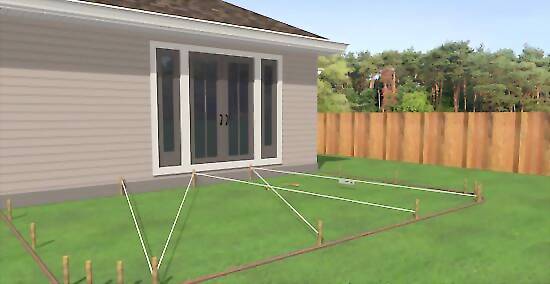
Measure out and mark the dimensions of the patio. It may be useful to stake out the corners and sides in order clearly identify the area as you work. Leave an appropriate gap along the outside edge of the bricks for the border (whether of lumber or pavers).
Excavate the site with a shovel. The depth to which you dig will be determined in part by the number of layers you intend to lay down. If you will only be laying down sand, just four inches or less may suffice. If you're going to deposit a layer of crushed rock or gravel first, it may be ideal to dig the area to a depth of eight inches. If the patio is going to be right next to your house, you may want to encourage water to run away from the foundation of your home. In this case, as you dig you can slope the ground away from the direction of the house. For each foot of length, add an additional 1/4 inch of depth to the excavation. Remove any large roots that may be apparent, even those just at the planned base of the dig. These can grow up through the bottom layers and undermine the stability of the patio. If you intend to use pavers for the border, dig deeper along the edge. This will allow you to stand the pavers up on end.
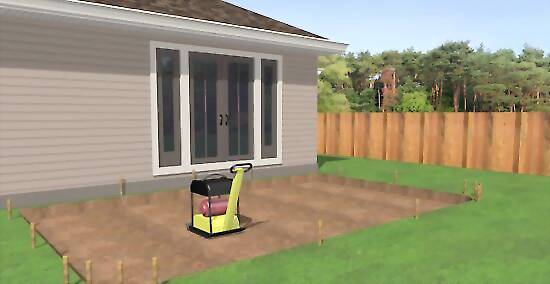
Tamp down the soil. The soil must be firmly in place if it is to support the weight of the patio. If you are using a manual tamper this process can take some time, but it cannot be rushed.
Lay down the gravel or crushed rock. It should be spread out up to a depth of four inches. Make sure to maintain the integrity of the slope you may have created earlier. The rock should also be tamped into place to solidify the foundation of the patio.
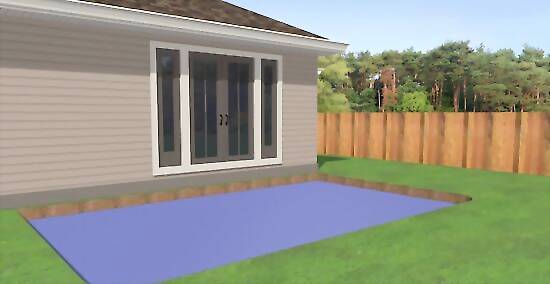
Cover the rock (or soil) with the landscaping fabric. This should prevent the growth of weeds.
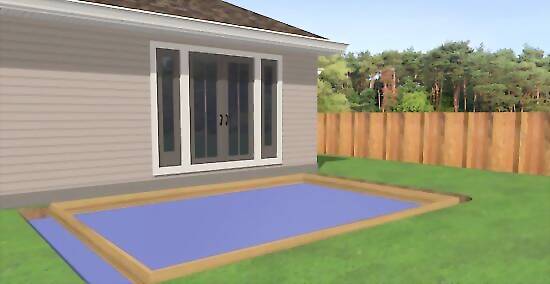
Install the border. If you are not digging deep or laying down a rock layer, you may want to do this immediately following the excavation. It may be desirable to screw the boards together if lumber is being used as the border. The added stability will help hold the patio in shape. If pavers are being used, stand them up in the trench you dug for the edge and tap them into place. Try to fit them as snugly together as you can. Whether using boards or pavers, make sure that your border is installed at the desired angle (or, more likely, with no angle) by using a level.
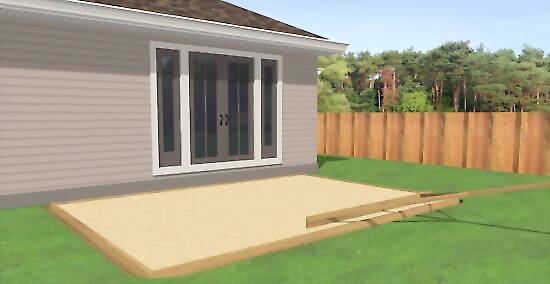
Partially fill in the site with sand and then screed it level. One to two inches are considered a reasonable amount, and it is no longer desirable to maintain the slope you may have created earlier. It is now necessary to level off the sand with a screed (which is a term used for any object used to scrape or level). You can make a screed out of spare lumber. Tamp down the sand. Be careful not to disturb the level surface that you have created.
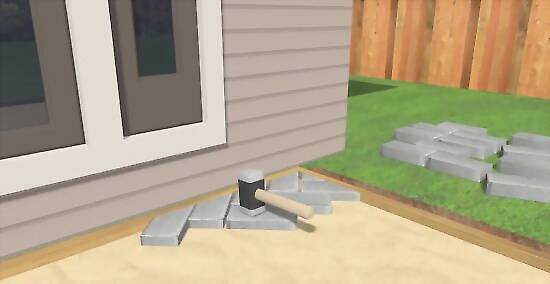
Lay the pavers into place. Press them into the sand as you lay them. Lay the pavers as closely together as you can and use a rubber mallet to seat them into the sand. Use a small level to check the bricks in 2 directions, and use at least a 6-foot level for a drainage slope.

Spread a layer of sand over the bricks. Carefully sweep the sand to fill in the cracks between the bricks and along the edge. Only do this after all the bricks are in place. If some of the bricks aren't in yet, sweeping the sand into unstable joints will cause the bricks to move around.

Gently spray the pavers with water. Use only a small amount of water, as using too much will wash the sand away and loosen the joints. This will allow the material to settle between the bricks. Your project is now complete. You can also sweep the sand away rather than spraying water.




















Comments
0 comment